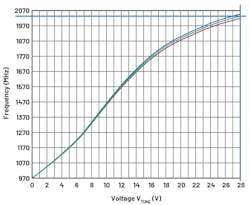Driving the VCO in High-Voltage, High-Frequency Phase-Locked Loops
A phase-locked loop (PLL) is a feedback system that combines a voltage-controlled oscillator (VCO) and a phase detector in such a way that the oscillator signal tracks an applied frequency or phase-modulated signal with the correct frequency and phase. PLLs are used when stable, higher output frequencies need to be generated from fixed low-frequency signals or when rapid frequency changes are needed. Typical use cases are in radio communication links as well as frequency synthesis in test-and-measurement equipment, including vector network analyzers (VNAs).
Figure 1 shows a block diagram of a PLL-based frequency synthesizer. The VCO generates the output signal. It’s maintained at the setpoint frequency by the PLL and locked to the reference frequency, and the reference frequency is typically supplied by a very accurate quartz oscillator. A frequency divider is provided in the feedback path of the PLL circuit in front of the phase detector to reduce the VCO frequency by an adjustable factor.
A VCO contains an adjustable tuning element, such as a varactor diode with a capacitance that changes depending on the input voltage. Thus, the PLL circuit is a kind of feedback control system for the VCO.
The required input or control voltage to the VCO is often higher than the supply voltage available to the PLL circuit. The supply voltage is typically 3.3 or 5 V, whereas VCOs may require voltages of more than 20 V depending on the desired frequency. To generate a wider range of frequencies, VCOs with a wider tuning range can be used. A simplified circuit example that supports VCOs in the gigahertz range is shown in Figure 2.
The DCYS100200-12 from Synergy Microwave Corporation, for instance, can be used as the VCO. It pumps out a frequency of 2 GHz at 28 V (VTUNE), as can be seen in the graph in Figure 3.
Generating the High Voltage
There are several possibilities for generating the high control voltage. One is using an active loop filter, which essentially consists of a high-speed amplifier and a low-pass filter that shapes the output pulses from the phase detector (CPOUT) into a clean dc voltage. Alternatively, a PLL frequency synthesizer with an integrated charge pump, such as the ADF4150HV from Analog Devices, which doesn’t require an additional active loop filter, can be utilized.
Even though both solutions require a high-voltage supply, the number of components can be reduced with the ADF4150HV. Distortion and phase noise caused by the active filter amplifier can also be ousted. Furthermore, the ADF4150HV can be used in fractional-N or integer-N PLL frequency synthesizers. Thus, it’s possible to divide the VCO frequency by 1, 2, 4, 8, or 16 to achieve output frequencies down to a minimum of 31.25 MHz.
The high voltages required for the ADF4150HV’s integrated charge pump can be generated with the ADP1613 dc-dc converter without compromising on the PLL’s performance. Used as a switching regulator, the ADP1613 has an integrated power transistor to achieve output voltages of up to 20 V. Higher output voltages are also possible by using additional external components, especially through an external power transistor.
The switching frequency of the ADP1613 can be adjusted from 650 kHz to 1.3 MHz, which leads to a better transient response and simple noise filtering. In general, using a switching frequency of more than 1 MHz is recommended so that switching noise can be reduced by the PLL filter.
The PLL frequency synthesizer with the ADF4150HV offers an ultrawideband PLL function when using the integrated RF divider. The part also covers frequencies of 62.5 MHz to 2 GHz. With the same PLL design, different frequencies can be generated for a multitude of different hardware platforms in the system. However, if you’re using various types of VCOs, it makes sense to incorporate a corresponding loop filter into the design. That way, you can make sure that the phase-locked loop functions reliably.
With its relatively wide output frequency range and higher output power, a small filter structure is also required on each of the RF outputs of the ADF4150HV. A 27-nH inductor in parallel with a 50-Ω resistor can be used for frequencies up to 3 GHz. The resistor offers a defined output impedance. Lower inductances would cause the frequency band to expand to lower ranges.
The PLL frequency synthesis simulation tool ADIsimPLL also supports the development of HF functional blocks and modeled high-frequency signal chains. It gives designers the ability to simulate the important nonlinear effects that could impact PLL performance; for instance, undesired spurs from the frequency-synthesis process (spurious frequencies).
Integrated solutions for larger frequency ranges (that is, for PLLs, filters, and VCOs) in one housing are also available. But these solutions can lead to undesired coupling due to how close the different parts are to one another. A discrete design and the resulting physical separation minimize this risk.
Thomas Brand is a Field Applications Engineer at Analog Devices.
References
“Voltage Controlled Oscillator Surface-Mount Model: DCYS100200-12.” Synergy Microwave Corporation, October 2014.
“Circuit Note CN-0228: Single-Supply Power a 28 V, High Voltage Phase-Locked Loop (PLL) Synthesizer.” Analog Devices, June 2014.



